 |
|||||
|
|||||
| Preview of Stamps Catalogue: VOLUME 1 |
 |
|||||
|
|||||
| Preview of Stamps Catalogue: VOLUME 1 |
Note: on my website many of the
pictures can not be seen! They are of course present in the catalogue;
contact me if you want to purchase it.
Value in 'pence' 1 p orange 2 p red 3 p blue 4 p black (1868) 6 p green 9 p (= 6 p Stg.) violet
The 2 p, 3 p and 6 p were first issued with perforation 9 on yellowish paper. Later, all values were issued on yellowish or bluish paper with perforation 12(?).
Value of the stamps |
|||
vc = very common c = common * = not so common ** = uncommon |
*** = very uncommon R = rare RR = very rare RRR = extremely rare |
||
| Value | Unused | Used | Remarks |
| 1 p | *** | *** | |
| 2 p | * | ** | |
| 3 p | * | *** | |
| 4 p | * | *** | |
| 6 p | *** | *** | |
| 9 p | *** | *** | |
Different design
4 1/2 p brown
This stamp has perforation 12.
Value of the stamps |
|||
vc = very common c = common * = not so common ** = uncommon |
*** = very uncommon R = rare RR = very rare RRR = extremely rare |
||
| Value | Unused | Used | Remarks |
| 4 1/2 p | *** | *** | |
Value in 'cents'
1 c orange 2 c blue 3 c red 4 c green 6 c black 12 c violet
Value of the stamps |
|||
vc = very common c = common * = not so common ** = uncommon |
*** = very uncommon R = rare RR = very rare RRR = extremely rare |
||
| Value | Unused | Used | Remarks |
| 1 c | * | *** | |
| 2 c | * | *** | |
| 3 c | ** | *** | |
| 4 c | * | *** | |
| 6 c | * | *** | |
| 12 c | * | *** | |
Many of the above stamps also exist bisected (forged bisected cancels also exist). An unofficial reprint of the 1 c orange was made (perforated 11 or imperforate).

Reprint in blue of the 6 p value, reduced size
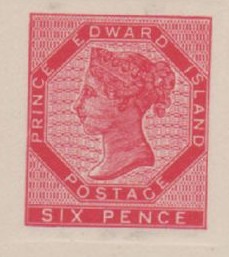
Zoom in of a red reprint of the 6 p value.
I've seen reprints of the 6 p value in black, green, bluish green, red (two shades), orange, brown, yellow and blue. They were all printed singly on a large piece of paper. Ken Pugh has told me that these were unofficial reprints made during World War I as a fundraiser. According to him: 'Harmer later used the dies for a philatelic dinner promotion'. The reprint in my personal collection is printed on very thick cartonboard paper.
Many of the above stamps are worth considerably more with cancel than unused. Forged cancels exist.
Genuine cancel?:

Forged cancel:

(Forged cancel)



Primitive forgeries of the 4 1/2 p stamp, left in goldcolour
(uncancelled) and right in brown (cancelled). There are still
traces of a printed perforation visible. This forgery can also be
found in the catalogue of Placido Ramon de
Torres "Album Illustrado para Sellos de Correo" of
1879 (information passed to me thanks to Gerhard Lang, 2016) on
page 223.

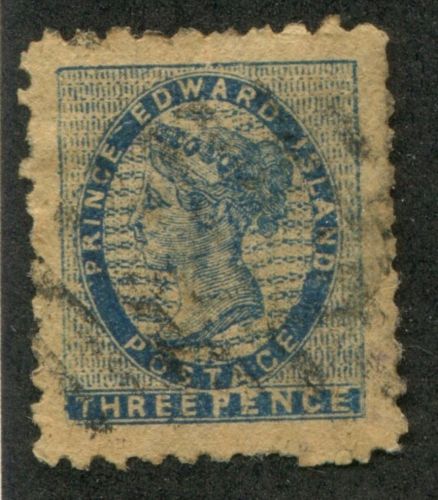
In this forgery of the 3 p blue stamp, the "T" of
"POSTAGE" is almost placed on top of the "P"
of "PENCE"; in the genuine stamps the "T" is
placed well in front of the "P". This might be an Oneglia product. He forged the 2 p, 3 p,
and the 6 p with perforation 9.
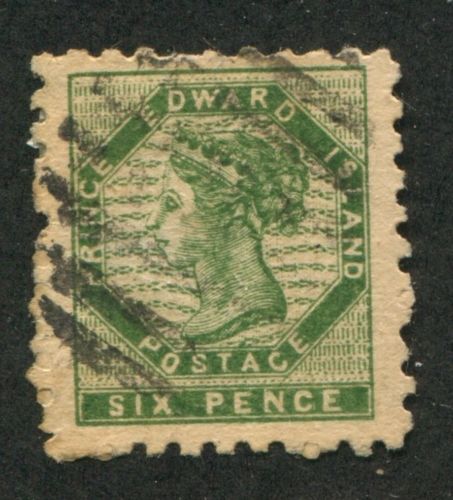

6 p green forgeries. The letters are all slightly different from
the genuine ones. For example the "DW" of
"EDWARD". This might be an Oneglia
product.

Another primitive forgery of th 3 p value

A Birmingham forgery of the 4 c value, the design enters the
value label on top of the "OU" of "FOUR" and
"EN" of "CENTS". These forgeries were
apparently made by A.Scott & Co of Birmingham (often using
the alias C.B.Post Office Birmingham) See:
http://fipliterature.org/biographies.PDF and
http://stamps.org/userfiles/file/library/TedescoIndex.pdf.
The following text was found in 'The Stamp
Collector's Magazine' Vol X, page 138, 1872 (is this the above 4
c Birmingham forgery?):
FORGERY OF THE NEW 4 c. GREEN PRINCE EDWARD ISLAND.
We have to warn all our readers—more experienced collectors,
equally with beginners —against a most dangerous forgery of
the above-mentioned stamp, in which the design, in all its
principal points, is most carefully imitated, and there is so
slight a difference in shade as to render comparison with a
genuine stamp necessary for detection. The most noticeable points
of variation between the forgery and the genuine stamp are as
follows :
—
GENUINE.
1.— The crown of the head of the portrait does not touch,
the frame. There is a plainly visible space between it and the
frame, along the whole length.
2.—The square disks in the lower angles, containing the
figure 4, are a trifle higher than the band running between them,
inscribed with the value.
3.—There is a clear space between the letter O in the word
POSTAGE, on the first line of the inscription, and the letter E
of PRINCE in the second line.
4.—There is a vertical line of fine dots outside the
exterior row of fins horizontal lines which forms part of the
ground on the righthand side. In other words, each one ofthese
horizontal lines is succeeded by a dot.
FORGED.
1.-The crown of the head touches the frame along a certain
distance, and in a direct line under the letters DW of the word
EDWARD in the inscription in the upper margin.
2. -The square disks in the lower angles, containing the figure
4, do not project above the intervening band, inscribed with the
value.
3. -The letter O in the word POSTAGE, in the first line of the
incription, touches the letter E of PRINCE on the second line.
4. -The line of dots, referred to on the other side, is absent.
We could go on multiplying the distinctive characteristics, but
we have been careful to mention only those positive differences
whereby the forgery can be at once detected by itself, without
the necessity for comparison with a genuine specimen. These
dangerous counterfeits are also sold obliterated, and the false
postmarks have not been applied —as is usually the case with
forgeries— in such a manner as to leave the best part of the
stamp clean, but are struck over the stamps with apparently
official carelessness, and thus are all the more deceptive. The
genuine cancelling mark consists of a transverse oval, formed of
ten horizontal bars, of which the top and bottom ones are curved,
so as to complete the oval. The forged mark consists of an
irregularly shaped transverse oblong, formed of two horizontal
lines of long, and three of short unshapen patches. They are sold
three or four together, stuck on paper, and have every appearance
of having been cut from an envelope. The unused forgeries are
sold in sheets of 100, at fourpence each specimen. We are glad to
learn, from our Birmingham contemporary, that the matter has been
communicated to the proper authorities, and that the home agents
of the colonial postoffice have been instructed to take such
action in the case as will bring the offenders to justice. We
shall rejoice if they get their deserts, and we have no doubt our
readers will be equally glad ; meanwhile, as these spurious wares
have been launched into circulation, it will be well to take
every precaution, to prevent their being imposed on collectors.
This Birmingham forgery was also described (with image) in The Philatelic Journal by E.L.Pemberton of August 15, 1872, page 140-141.
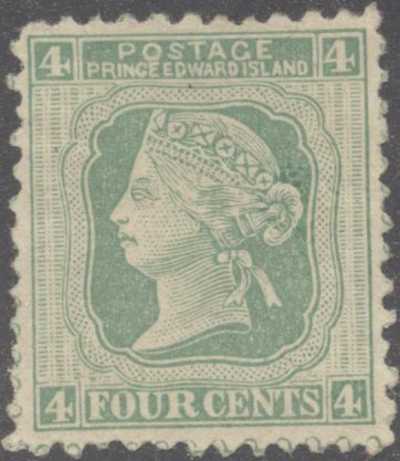

Yet another forgery, with printed perforations. This forgery can
also be found in the catalogue of Placido
Ramon de Torres "Album Illustrado para Sellos de
Correo" of 1879 (information passed to me thanks to Gerhard
Lang, 2016) on page 223.
Bogus issue (15 c blue!), cancel 'Charlotte-town'. This issue is a bogus issue by an American dealer (according to Album Weeds, he probably refers to Allan Taylor).
and a bogus value of 10 c.

(15 c Taylor bogus issue, reduced size)
Taylor also made a forgery of the 4 p stamp (with missing mouth!) and a primitive forgery of the 4 1/2 p. If you posess a picture of the 4 1/2 p forgery, please contact me!

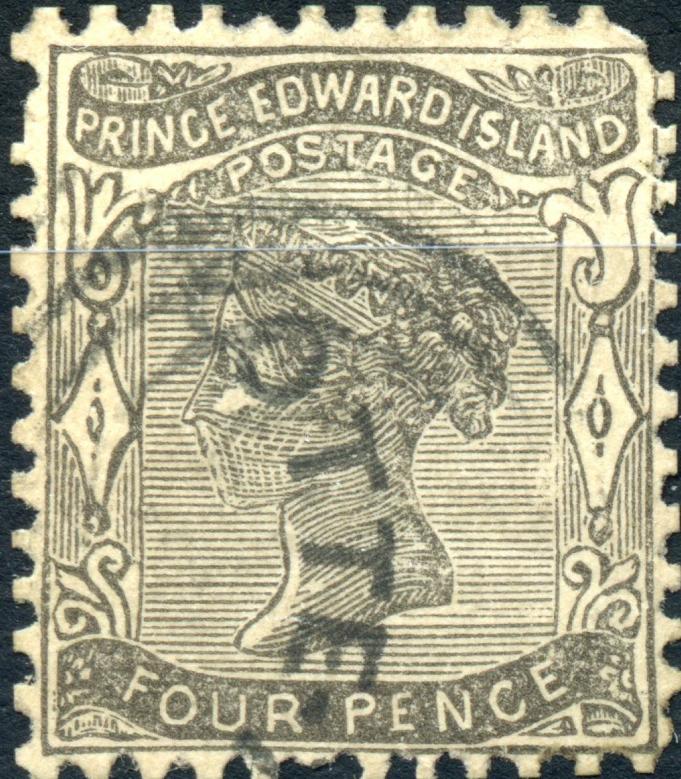
Taylor 4 p forgery with missing mouth.
Ken Pugh contacted me a told me that he believes these forgeries were not made by Taylor. According to him: 'Taylor did not perf his forgeries, and they appear as multiples. Taylor used only one of each stamp on his cliches.'. It is indeed so, that all the bogus issues of the United States that Taylor made were all imperforate. However, in the book 'Philatelic Forgers, Their Lives and Works' by Varro E. Tyler an advertisement can be found with the heading of Taylors last price list (on page 47) which reads:
S. Allan Taylor
40 Kilby St., Boston, Mass.
.......Dealer in...
Reprint or Fac-simile Stamps for Collectors.
These cancelled fac-simile stamps have been provided for the
purpose of
meeting the wants of that class of collectors whose object is
knowledge of th
stamp issues of the world, and not aimless acquisition. they are
cancelled and
have holes round the edges and
serve every purpose of originals.
Here the full advertisement:
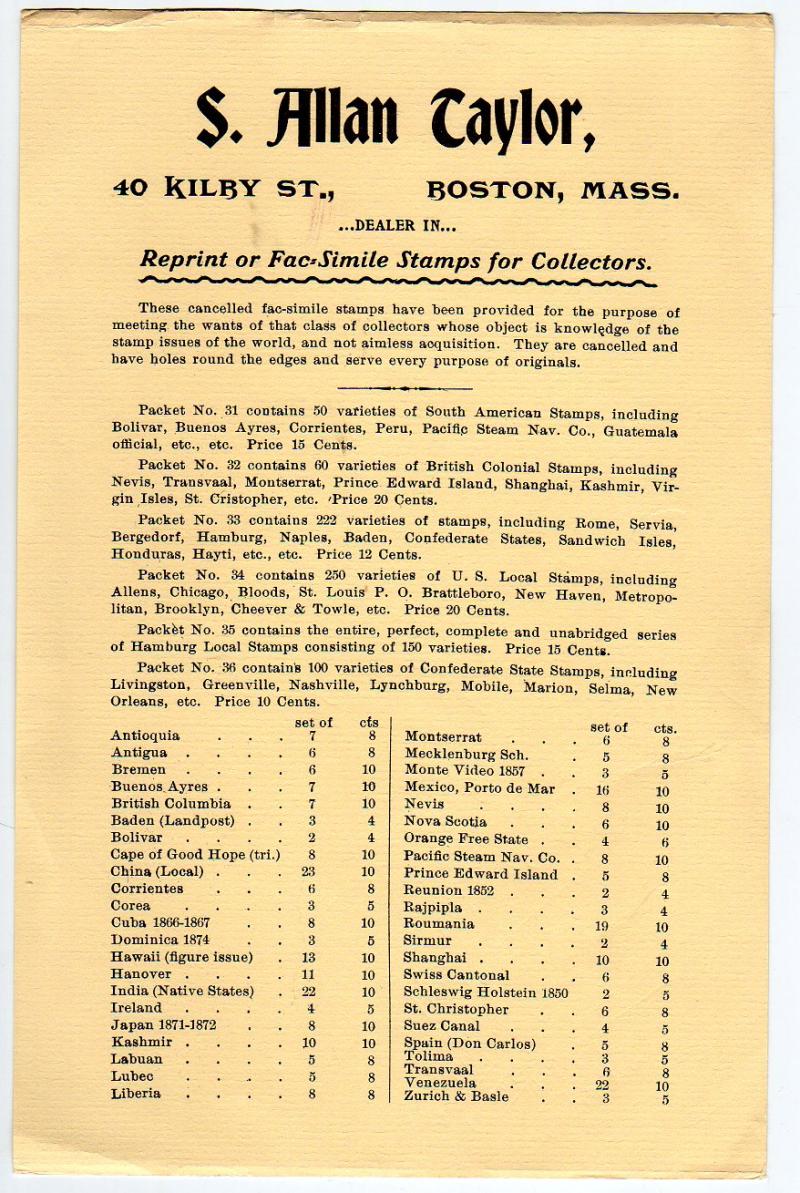
The words 'holes round the edges' clearly indicated that they are perforated..... Captain R.B. Mitchell in 'Fakes & Forgeries of New Brunswick and Prince Edward Island' also attributes them to Taylor. According to Ken Pugh, it is most likely though, that Taylor sold the above forgeries only and that he did not make them.
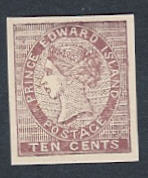

Forgery resembling an illustration from a Moens catalogue of the
bogus 10 c value.
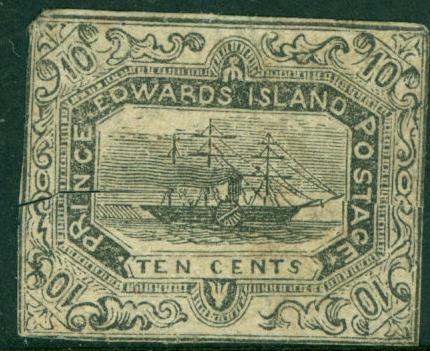
Taylor 'Prince Edwards' bogus issue
A bogus issue with a ship and inscription "PRINCE EDWARDS ISLAND" ("EDWARDS" with "S"), was issued by the stamp forger Allan Taylor. The book 'The mystery of the Prince Edward Queen' by William J.Eckhardt mentions that in December 1886 a bogus stamp was issued also with wrong inscription 'Prince Edwards Island', in black on yellow paper, imperforate. This forgery was made by Charles Lyford, an accomplice of Allan Taylor. Probably, these are the same forgeries. Apparently, this stamp inspired Taylor to make the above (much more convincing) forgeries.
A bogus issue for Prince Edward Islands, with Queen Isabella of Spain (!):

(Reduced size)
A letterhead from Arthur A. Bartlett is sometimes cut out and sold as genuine:
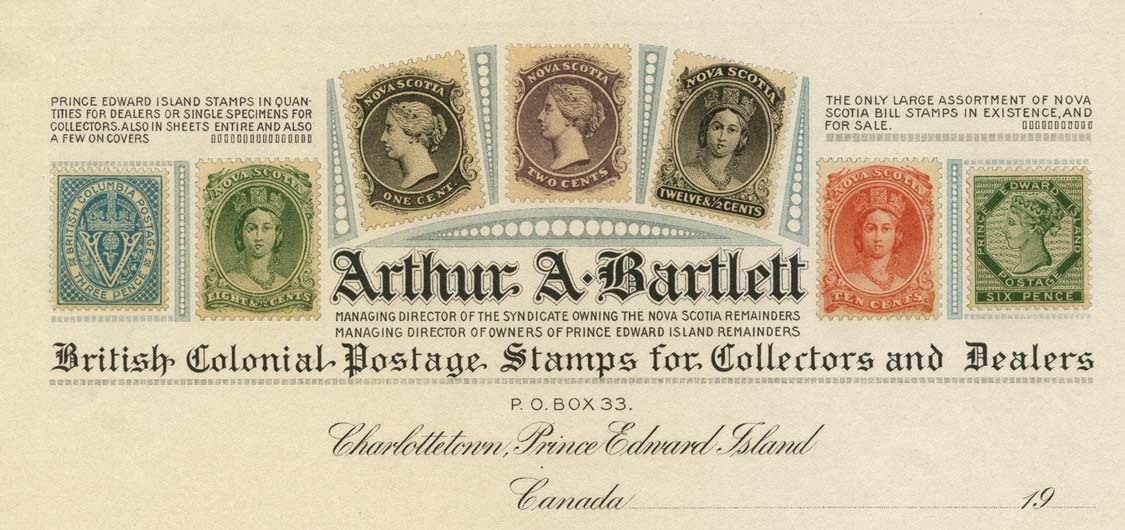


Zoom-in of the Bartlett letterhead.

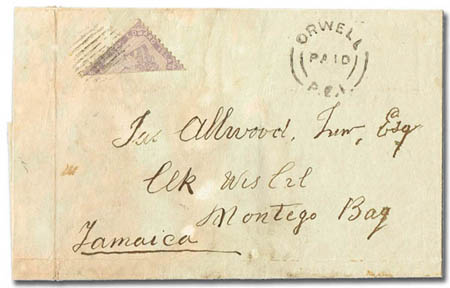

Forged bisected stamps on covers, they might have been made by
stamp forger Raoul de Thuin.
Stamps - Timbres-Poste - Briefmarken